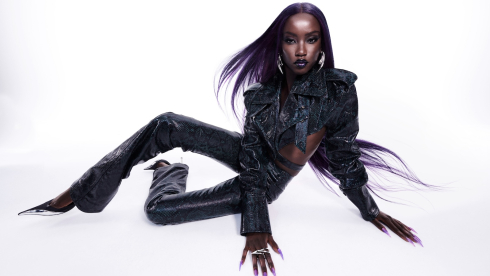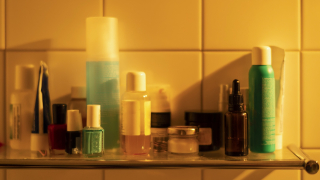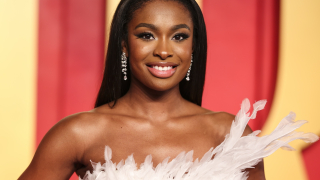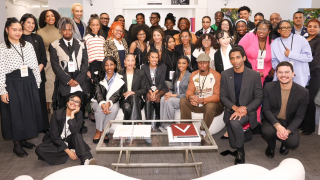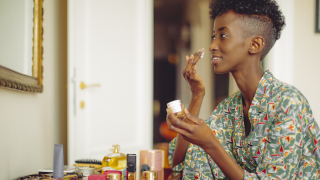It’s more than art for art’s sake. Justin Adu’s African Amedia exhibit was created with direct intent to deliver in-your-face content that forces one to take in the adversities of society. His work addresses the negative portrayals of African Americans in mainstream media, while also providing a platform to look inward and analyze self.
At the height of social injustice, visible youth activism and a solid movement powered by #BlackLivesMatter, this layered idea came to Adu three years ago, took a year and half to install, and still resonates with societal ills today.
Constructed with the use of mixed media paintings, video, art installations and photography, Adu created a faux television station that plays on stereotypes and skewed perceptions of Black culture and behavior, with hope that people acknowledge the sour taste of racism in its various subtleties.
The exhibit—launched in May at the African American Museum of Dallas—received an extended run-date through November 14. Adu teases, “There will be a surprise performance in there. I need to make sure that my message is resonating with you in some way so that you can spark a change.”
Adu, who recently took home the AdColor Rising Star award, spoke with EBONY.com about using art as a tool to silence destruction, African Amedia as an educational installation, and creating with the intent to drive awareness and critical conversation. Take in the art and message below.—LaToya Cross
EBONY: There are a lot of moving pieces to this project. What are the various dynamics that make up African Amedia?
Justin Adu: What I wanted to do was create a direct visual that could show people how we were being portrayed in the media. As a visual artist, I always want to make sure that I’m bringing across a message within my work. So not only did I do the exhibit that consists of installation and wall pieces, but we did a one-night performance piece.
The cool thing was that when you saw it, it was like you were actually watching a television station. We had channels like Breaking Black News that showed recent protesters and how they were being portrayed. One channel touched on how women and African Americans get sexualized through different content. It played on Miley Cyrus and the whole twerking infatuation that has been happening. That was on the History Channel.
We used a guy who was from Africa to discuss how various practices and traditions in Africa have been misconstrued and projected inaccurately. He says: “And now we call upon our ancestors to bring life into this dance that we do for homegoing ceremonies, for weddings, and how this dance is not sexualized in Africa.” It was a huge project.
EBONY: We’re in an age where attraction is piqued by interaction. I’m sure the multimedia aspect and moving pieces of your exhibit aided into its extended debut at the African American Museum of Dallas.
JA: Yeah! Once they told me they wanted to extend it, I was really happy about it. Because this has really been a tough year in general, and I think that the more we can expose—not just with our people, but everyone—the more people can take a step back and really take in what’s happening in the world. At the end of the day, we have a lot of different social media platforms that we use. I really challenge people to do their research and not judge people [solely] by what they see on television.
EBONY: With your work, can you talk about the role of citizen journalism and its impact on capturing stories of injustice, as well as how you were able to fuse that into African Amedia?
JA: I think that it’s so relevant today, because that’s how a lot of big stories are breaking. It’s no longer the CNNs that are breaking these stories. Through the power of the camera phone, everyone has access to post whatever they want online. The way that I infused that into my work was saying that we have citizens who are eyewitnesses to everything going on, and these videos are coming straight from them. You can hear and see them, yet the verdicts have never been in favor of our people.
I just find it so interesting, because it’s something so blatant and in your face. Yet the judicial system can’t seem to find a satisfactory verdict when it comes to a lot of these cases. I have an installation of roughly about 14 TVs stacked on top of each other. I used a lot of the videos and reports that different people posted, and that’s what I have showing on all of the TVs—to keep that content alive and show people this is something you can’t ignore.
EBONY: With this project or the depths of your work overall, how do you see art raising the issue and also moving us forward with solutions?
JA: It raises the issue by addressing the word racist or racism—a word, I think, we don’t use. So I wanted to have a strong piece to where people can say racism is still alive. It’s happening very lightly, to where it’s being put into a form of entertainment. And you can see that with Miley Cyrus. It’s being put into the form of social media, even to how long it took for people to have colored emoticons. There are so many light subtleties, and I just wanted to say, “Look people, this is an issue!”
Even with Viola Davis and her recent win. This is the 67th Emmy Awards and it’s like, what?! I also wanted to challenge people to be proactive, and that comes in a lot of different forms. I think DeRay [McKinnson] is a perfect example. He’s on the ground running and a lot of people give him flack for his social media presence. The way that our ancestors and those before us expressed themselves and utilized their platform to work and do different things was completely different than now. I think some people are expecting for us to react the same way.
The truth of the matter is, it’s 2015. And however you choose to be proactive, I want people to continue to have that conversation until there are results. And I think the results will be when we live in a time where we are no longer seeing, on a constant basis, African Americans being mistreated on television.
EBONY: Let’s touch on the accountability aspect for a moment, because that’s something that’s often overlooked. Do you think African Americans are taking ownership of self and actions?
JA: There was a guy who emailed me; this was an interesting perspective. He told me that [African Amedia] really changed his life in terms of how he conducts himself. I was like, wow. He said, “[Mainstream media] really does try to project you in [a negative] light, and I sometimes pick that up.” Even in terms of our own people, it’s easy for me to be a teenager and see a rapper with their pants down and chains and then think it’s cool. But then I think the accountability of ourselves is a big thing. What we’re doing and how we’re putting ourselves out there is important.
EBONY: I think that should be a part of the conversation, from an inner cultural standpoint. What have been other reactions to African Amedia?
JA: It varies. Overall, it has been received well. Some people are able to walk in and nail what I’m trying to do instantly. Some people have different opinions in regards to the different pieces. For example, I have a couch that says Don’t Sit Your Black Ass Down. A lot of the older people love it. They say, “That’s what we used to say in the old days: ‘Go sit your black ass down.’ ” But the couch says Don’t. It’s almost a play on that generation, where I’m telling the generations of today to continue to get out there and make your voice known.
EBONY: Imagery can speak volumes. What are your thoughts on using art to silence destruction? Do you view your work as a silent protest?
JA: That’s a big one. Whatever I do, I always want to make sure there’s an emotion that I’m evoking to people. If the cause is to make people happy, I want to do that. If it’s to make them laugh, I want to do that. I think you bring up a very good point, because even through what you do, writing is such a form of art in and of itself. And you’re utilizing that art to be proactive and tell the stories of African Americans through entertainment and social activism. I make sure that, conceptually, I have an idea to where I am going to change the world.
What’s also important is making the history books. It’s so important for me to use my craft and what I’ve been blessed with to be educational, and not just put a picture on the wall, but to have some type of emotion in there. I think that’s why I resonate with so many people and artists who do that.
I just want us to get back to a place where there is a celebration of African Americans and what we’re doing. It’s like a light has been dimmed for some reason. I don’t know when that light is going to come back up, but there’s definitely some energy in the present that has to be acknowledged so that it doesn’t continue.
EBONY: What’s next for you? I get the feeling that something is already brewing.
JA: Working on first full-fledged play. I’m really excited about getting that off the ground and will probably start casting in December. I’m just really grateful, and not a day goes by where I don’t understand the shoes that I’m sitting in and what I’m able to do and contribute to the world, and most importantly my people.
African Amedia is exhibiting at the African American Museum of Dallas through November 14. To learn more about Justin Adu and his work, visit aduyou.com.





